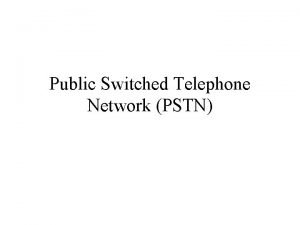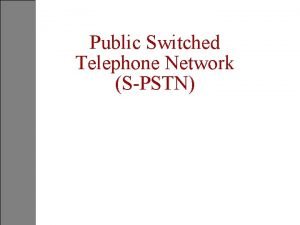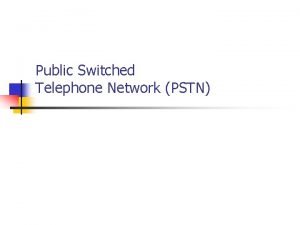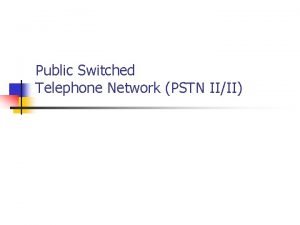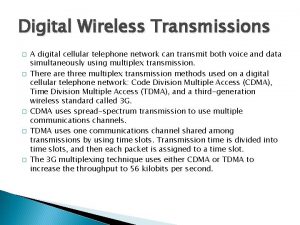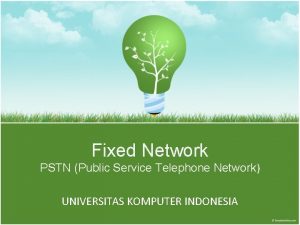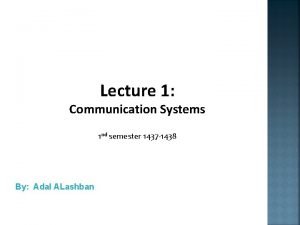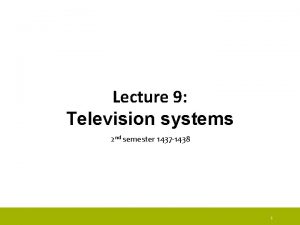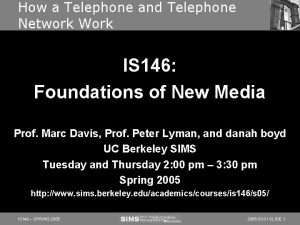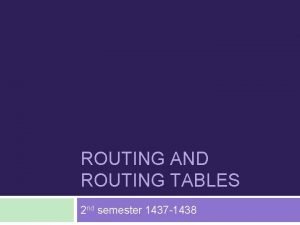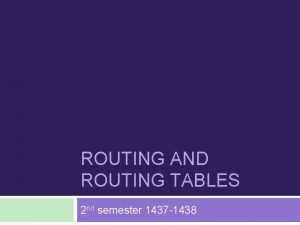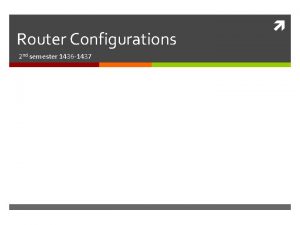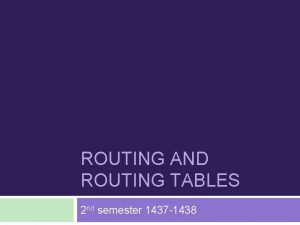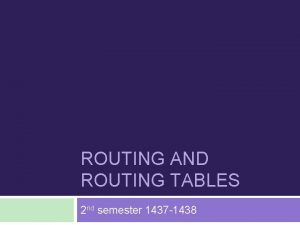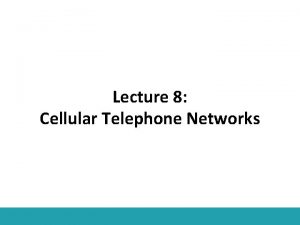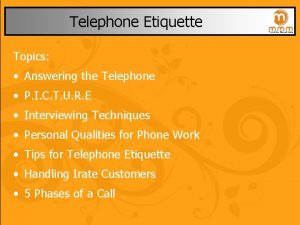Lecture 5 TELEPHONE NETWORK 2 nd semester 1437






















- Slides: 22

Lecture 5: TELEPHONE NETWORK 2 nd semester 1437 -1438 1

Outline 2

Introduction • Telephone networks use circuit switching. • The telephone network had its beginnings in the late 1800 s. • The entire network, which is referred to as the plain old telephone system (POTS), was originally an analog system using analog signals to transmit voice. • With the advent of the computer era, the network began to carry data in addition to voice. • During the last decade, the telephone network has undergone many technical changes. 3

Major Components • The telephone network is made of three major components: local loops, trunks, and switching offices. • It has several levels of switching offices such as end offices, tandem offices, and regional offices. 4

3. Switch 2. Access Line (Local Loop) 3. Trunk Line 2. Access Line (Local Loop) 2. & 3. End Office Switch 6 -5

Local Loops • It is a twisted-pair cable that connects the subscriber telephone to the nearest end office or local central office. • The local loop, when used for voice, has a bandwidth of 4000 Hz (4 k. Hz). • For telephone number associated with each local loop. • The first three digits of a local telephone number define the office • and the next four digits define the local loop number. 6

Trunks • Trunks are transmission media that handle the communication between offices. • A trunk normally handles hundreds or thousands of connections through multiplexing. • Transmission is usually through optical fibers or satellite links. 7

Switching Offices • A switching office has switches connects several local loops or trunks and allows a connection between different subscribers 8

LATAs • Local access and transport area (LATA) is a term used in U. S. telecommunications regulation. • A LATA is a geographical area established for the provision and administration of communications service. • A LATA can be a small or large metropolitan area. • A small state may have one single LATA; • a large state may have several LATAs. • A LATA boundary may overlap the boundary of a state; part of a LATA can be in one state, part in another state. 9

LATAs 10

Intra-LATA Services • The services offered by the common carriers (telephone companies) inside a LATA are called intra-LATA services. • The carrier that handles these services is called a local exchange carrier (LEC). • After 1996, more than one carrier could provide services inside a LATA. 11

Intra-LATA Services • Communication inside a LATA is handled by end switches and tandem switches. • A call that can be completed by using only end offices is considered toll-free. • A call that has to go through a tandem office (intra-LATA toll office) is charged. 12

Inter-LATA Services • The services between LATAs are handled by interexchange carriers (IXCs). • These carriers, sometimes called long-distance companies, provide communication services between two customers in different LATAs. • The IXCs are long-distance carriers that provide general data communications services including telephone service. 13

Points of Presence 14

circuit-switching • The telephone network, at its beginning, used a circuitswitched network with dedicated links (multiplexing had not yet been invented) to transfer voice communication. • circuit-switched network needs the setup and teardown phases to establish and terminate paths between the two communicating parties. 15

Signaling • In addition to carrying the actual voice signals, the telephone system must also carry information about the call itself • This is referred to as system signaling or inter-office signaling • There are two approaches to system signaling: in band out of band 16

Signaling • In band signaling: the 4 -k. Hz voice channel is also used to provide signaling. . • Out-of-band signaling: the voice bandwidth and the signaling bandwidth are separate. 17

Signaling • The signaling system was required to perform other tasks such as • Providing dial tone, ring tone, and busy tone • Transferring telephone numbers between offices • Maintaining and monitoring the call • Keeping billing information • Maintaining and monitoring the status of the telephone network equipment • Providing other functions such as caller ID, voice mail, and so on 18

Signaling • The tasks of data transfer and signaling are separated in modern telephone networks: data transfer is done by one network, signaling by another. • Although the two networks are separate, this does not mean that there are separate physical links everywhere; the two networks may use separate channels of the same link in parts of the system. 19

Data Transfer and signaling Networks • The data transfer network that can carry multimedia information today is, for the most part, a circuit-switched network, although it can also be a packet-switched network. • The signaling network, which is a packet-switched network involving the layers similar to those in the OSI model or Internet model, 20

Services Provided by Telephone Networks • Telephone companies provide two types of services: analog and digital • Analog Services • • dial-up service 800 service 900 services Analog Leased Service ( a dedicated line). 21

Any Questions? 22
 01:640:244 lecture notes - lecture 15: plat, idah, farad
01:640:244 lecture notes - lecture 15: plat, idah, farad Public switched telephone network diagram
Public switched telephone network diagram Transmission plan in telephone network
Transmission plan in telephone network Pstn hierarchy
Pstn hierarchy Pstn
Pstn A satellite used in a cellular telephone network
A satellite used in a cellular telephone network Managing entity network management
Managing entity network management Public service telephone network
Public service telephone network Graph neural network lecture
Graph neural network lecture Telecommunication network management lecture notes
Telecommunication network management lecture notes Datagram switching and virtual circuit switching
Datagram switching and virtual circuit switching Network topology in computer network
Network topology in computer network Features of peer to peer network and client server network
Features of peer to peer network and client server network Ece 526
Ece 526 Network centric computing and network centric content
Network centric computing and network centric content Circuit switching vs packet switching
Circuit switching vs packet switching The press television and radio
The press television and radio Kalama telephone company
Kalama telephone company Telephone manner adalah
Telephone manner adalah Pros and cons of telephone interviews
Pros and cons of telephone interviews Telephone answering procedures
Telephone answering procedures Telephone conversation by wole soyinka quiz
Telephone conversation by wole soyinka quiz Take part in a telephone survey
Take part in a telephone survey

